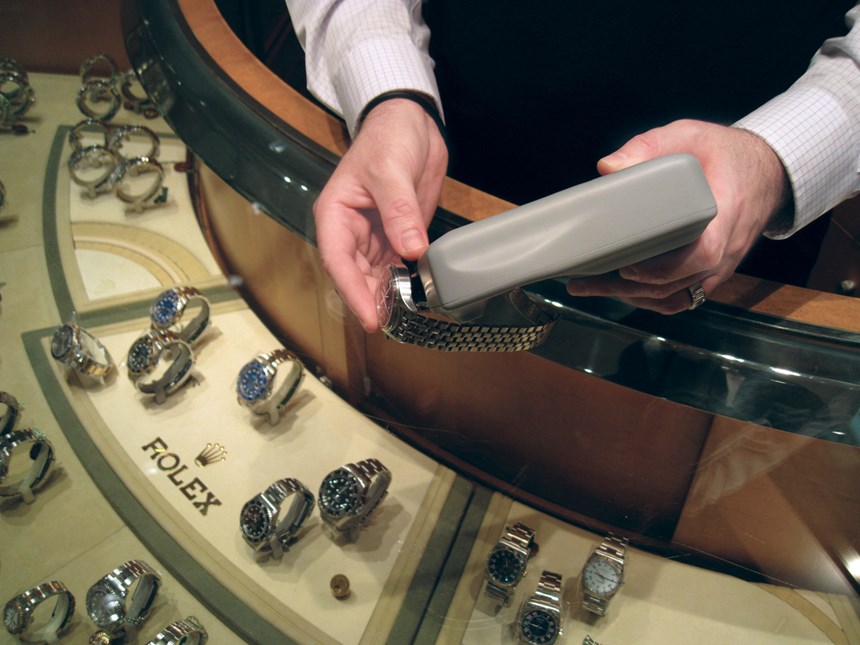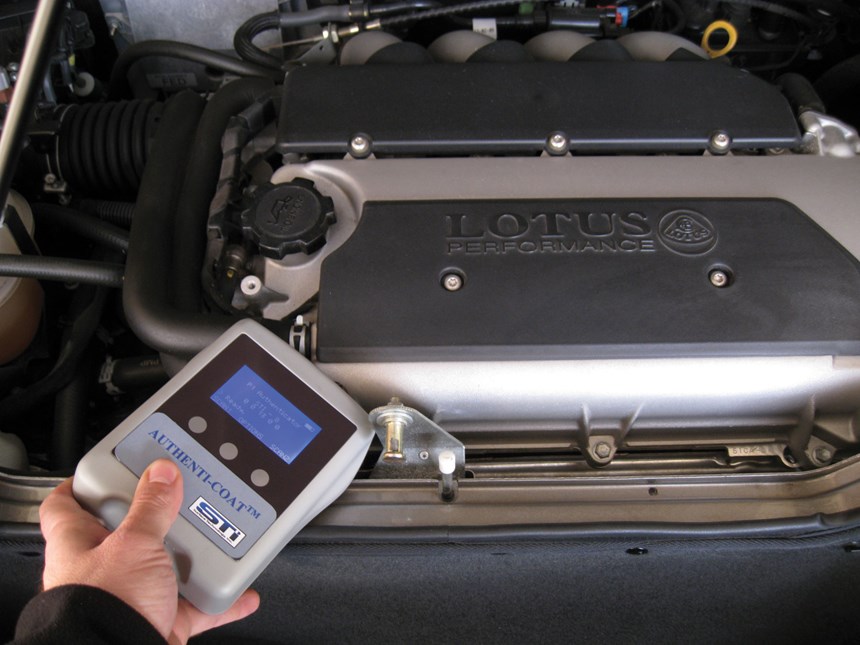Electroless Nickel Solution Adds Chemical Marker
The day may have arrived when finishers can now grab a small electronic device and test to see if the rejects coming back to them were actually finished in their shop, and not, say, in the customer’s second-source finisher.
The customer on the phone has said what might be the single most frightening word uttered to a finisher: rejects.
Faced with spending hundreds—if not thousands—of dollars to strip and re-finish the parts a customer is shipping back, most coaters would simply throw up their hands and mumble a few choice words.
But the day may have arrived when finishers can now grab a small electronic device and test to see if the rejects coming back to them were actually finished in their shop, and not, say, in the customer’s second-source finisher.
That’s the promise of Surface Technology Inc. (Trenton, NJ) and its president, Michael Feldstein, who recently presented the concept of incorporating novel ‘markers’ into a coating at Products Finishing magazines’ Electroless Nickel Conference in Charleston, SC.
Traceability
The idea of the chemistry is to determine where a part was coated, and even what day and shift it may have been finished, if that information is necessary.
“Before you strip the 10,000 parts returned by your customer for out-of-spec plating, wouldn’t you like to know for sure that the parts were actually plated in your shop, and not the customer’s inferior second source plater?” Feldstein asked the coaters, calling these unique markers the equivalent to a “chemical barcode within a coating.”
Feldstein has been working with some of his customers on fine-
tuning the process using his company’s NiPlate 007 electroless nickel chemical solution.
“We have a few companies that are doing initial tests with the coating on a variety of applications,” he says. “Some are large volume industrial parts and some are high-end and brand name consumer applications. My company and our partner on this technology will be jointly marketing it to our respective clients and then further develop the market.”
His customers seem to like the result so far.
“I was very impressed with this new coating technology the minute I heard Michael’s presentation at the EN Conference,” says Roger Plath, president and CEO of Twin City Plating in Minneapolis, MN. “It has the potential to immediately solve the open needs of many of my customers, and I’m moving ahead on trials of this coating on a variety of parts used in different industries.”
Feldstein and his company are not new to innovations. He got the idea for the coating markers after developing electroless nickel coatings with light emitting properties, which appear normal under traditional lighting, but emit a distinct brightly colored light under an ultraviolet light.
One of his customers was finishing a part with STI’s CDC Composite Diamond Coating, but they wanted to be able to determine when the coating eventually wore off so they could replace it and prevent damaging the base metal piece under it.
STI received three patents for designing coatings that each give off a different color glow when a UV light source is shined on the coating. This makes it possible to see when these functional coatings have worn through, to avoid wear or damage to the part itself, and to prevent inferior or out-of-tolerance products from being produced from a worn part.
“While the existing composite light emitting EN coatings have been a useful technology for many applications, the need for coatings with even greater indicating properties has still existed,” Feldstein says. “The new technology serves these needs by allowing coatings with many more levels and varieties of identification with more convenience to the plater and end-user.”
History of innovation
Founded in 1973, Surface Technology, Inc. has over 90 U.S. and foreign patents in metal finishing, with many more pending. STI also has agreements to over 40 licensees, including most all of the top electroless nickel suppliers.
STI’s proprietary chemicals include Addplate, Composite Diamond Coating, NiPlate, NiSlip, Nano-Plate, ENBO, Surfcat, Promoter, Deburr 1000, Bor-Fuse and Pitless NF.
STI makes all of its technologies available as both services from its production facility or through chemical products available for customers to use themselves. Feldstein says his technology involves a family of materials that has been developed using specially engineered substances that each can be detected by a simple electronic meter, a test he says is noninvasive, instantaneous and infinitely repeatable.
“These materials are chemically inert, safe and strong enough to persist in almost any conditions, including an EN plating bath and heat treatment,” he says. “Only small amounts of the ceramic-based materials need to be co-deposited into the EN coating to make their properties evident to the electronic meter.”
That means the small presence of the material in the coating is not easily visible and does not affect the performance of the coating in other regards, he says. The material used in this technology is non-hazardous, but Feldstein says it has not been approved for food applications other than secondary packaging.
While the primary application of the indication technology is in electroless nickel, Feldstein says other forms of plating (other electroless alloys, electrolytic, brush, immersion) and non-plating coatings can use the technology.
Simple Process
Here’s how Feldstein says the process works:
• Each detectable material can be assigned a number or a name. The electronic detector can be programmed to recognize each material and indicate the presence of one or multiple materials according to the pre-assigned number or name.
• For example, if a composite EN coating is produced with material “A” within the EN, the detector will report the presence of “A” in the coating when it is pointed on the surface of the coating. If the coating contains material “B,” the detector will report “B.” If the coating contains both “A” and “B,” the detector will report both “A” and “B” and so on.
Feldstein says the ability of the electronic device to detect multiple materials—and the existence of dozens of such proprietary materials—means that hundreds of combinations can be employed within an EN coating, allowing the finisher the opportunity to have coatings with embedded ‘codes’ that indicate whether the parts were plated by them or another coater.
Paul Szymanowski, president of Micro Plating in Erie, Pa., thinks the technology could catch on in the coating industry.
“I think adding markers to coatings is an excellent idea to provide traceability,” Szymanowski says. “With electroless nickel coatings so costly to strip, yes it has come across my mind if this was indeed our coating. Anything that adds to quality through traceability is of value. I would include this technology immediately.”
Some skepticism
David Osmolski of Charlotte Plating wonders how the technology may be used.
“I am sure somewhere there is a market for this kind of identification, but that market is probably in a lawyer’s office somewhere, where a case can be made against the finisher for some failure, real or imagined,” Osmolski says.
“Realistically, there will be failures of anything we manufacture, and these failures can be traced to both shoddy workmanship and reasons that are far beyond our control. As a rule, shoddy workmanship is evident from the start. For an average company doing an average finishing job for an average customer, identification is exquisite overkill.”
But Szymanowski says having markers in coatings would be a good way for OEMs to determine which supplier is meeting specifications.
“There have been a few times that we have had to strip coatings from some other supplier that never came close to the specification callout,” Szymanowski says. “A coating that can be traced back to the original processor will hopefully weed out these types of organizations.”
Osmolski said he could think of a few other uses for the markers in the coatings.
“This technology has been in use for some time now in the explosives industry,” he says. “It probably should be in use in the ammunition industry too. Identification is very useful for law enforcement tracing of criminal and terrorist activity.”
Help with counterfeiting
There’s also a secondary importance for the markings: OEMs can now determine almost immediately whether their parts are authentic, or are a knockoff. And with the World Customs Organization saying there is a $512 billion global counterfeit problem each year, there is a great advantage for manufacturers to determine what is real and what isn’t.
“The aircraft industry is one example where the need exists to prevent the substitution of counterfeit parts,” Feldstein says. “Technicians simply need to hold the portable, battery-operated detector on the surface of parts and push one button to display the presence of the proprietary elements in the coating, and thereby confirm the authenticity of the parts prior to use.”
There are many other industries in which companies need to mark their parts as authentic and reduce loss of business to competitors, and Feldstein says coaters and finishers can use his technology to offer additional “value” to their services to OEMs by offering the unique markings in their processes.
“Markers allow companies to verify the authenticity and source of a product, as well as many other inventory tracking and control factors,” he says. “And manufacturers can reliably demonstrate for themselves and to end users that parts are truly original equipment and not counterfeit.”
Security features built in
Feldstein says there are also numerous security measures incorporated into the digital meters. Special circuitry has been installed, so the device cannot be reverse engineered, and it will shut down and lock out if any unauthorized programming or inspections are made, he says.
Feldstein was questioned at length by the attendees of Products Finishing magazines’ Electroless Nickel Conference about the durability of adding the markers, and whether they compromised the specs or integrity of the coatings.
“All composite EN coatings are perfectly conformal to the substrate’s geometry with strong adhesion, and provide hardness, corrosion resistance,” he says. “Composite EN coating processes are also consistent with regular EN in terms of pre-treatment, ability to do selective coating, bath operation, strip-ability and reasonable waste treatment.”
Related Content
Finishing Systems Provider Celebrates 150 Years, Looks to Future
From humble beginnings as an Indiana-based tin shop, Koch Finishing Systems has evolved into one of the most trusted finishing equipment providers in the industry.
Read MoreChicago-Based Anodizer Doubles Capacity, Enhancing Technology
Chicago Anodizing Company recently completed a major renovation, increasing its capacity for hardcoat anodizing and Type II anodizing.
Read MoreBryan Leiker, MFACA, Discusses CARB Public Hearing Over Calif. Hex Chrome Ban
Bryan Leiker, executive director, Metal Finishing Association of California, offers a recap of a January 27, 2023, public hearing conducted by the California Air Resources Board prior to an impending ruling on a proposed ban of hexavalent chromium use for finishing operations in the state.
Read MoreNADCAP Shop Digitizes to Eliminate Paper Trail
Customizable ERP software has transformed a 27-year-old manual metal finishing job shop into a state-of-the-art paperless company with full digital traceability in about 10 months.
Read MoreRead Next
Education Bringing Cleaning to Machining
Debuting new speakers and cleaning technology content during this half-day workshop co-located with IMTS 2024.
Read MoreA ‘Clean’ Agenda Offers Unique Presentations in Chicago
The 2024 Parts Cleaning Conference, co-located with the International Manufacturing Technology Show, includes presentations by several speakers who are new to the conference and topics that have not been covered in past editions of this event.
Read MoreDelivering Increased Benefits to Greenhouse Films
Baystar's Borstar technology is helping customers deliver better, more reliable production methods to greenhouse agriculture.
Read More
























